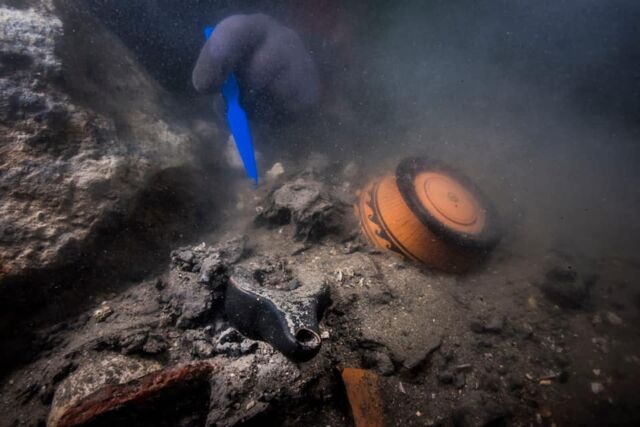
Twenty-four hundred years ago, Heraklion was ancient Egypt’s largest port on the Mediterranean Sea. Today, the ancient city lies submerged beneath Abu Qir Bay, a few kilometers off the coast of Alexandria. Archaeologists recently discovered the wreck of a warship from the city’s final years buried in the seabed for 2,100 years beneath five meters of clay and crumbled pieces of an ancient temple to the Egyptian god Amun.
A fast but unlucky warship
The outline of the wrecked ship suggests speed. Its 25 meter-long hull is about six times longer than it is wide, meaning that it was a long, sleek vessel built to race through the water. Clearly, this was no cargo vessel; ships built to haul cargo or passengers tend to be wider, built for capacity rather than speed and agility. The archaeologists from the European Institute for Underwater Archaeology who discovered the wreck say it was probably a warship, and its captain picked an unlucky day to tie up in the channel that flowed along the south side of the Temple of Amun in Heraklion.
Some of the city’s inhabitants called the place Heraklion; others called it Thonis, and archaeologists have found stone monuments inscribed with both names together. Coins and bits of pottery found among the city’s submerged ruins suggest that Thonis-Heraklion flourished from the 500s to the 300s BCE. When Alexander the Great founded Alexandria 32 kilometers to the southeast in 331 BCE, the new city replaced Thonis-Heraklion as Egypt’s largest Mediterranean port, and the older city began to decline.
By the 100s BCE, a series of earthquakes and tsunamis had battered the once-great city. One particularly severe quake caused the hard clay beneath Thonis-Heraklion to behave more like a liquid, and buildings all over the city collapsed. At the entrance to one canal, a cluster of Greek mortuary temples that had stood since the 300s crumbled. And the great Temple of Amun collapsed into the channel, raining huge blocks of carved stone onto the long, sleek warship tied up at a nearby wharf, according to Mustafa Waziri, the secretary-general of Egypt’s Supreme Council of Antiquities.
Archaeologists recently discovered the shipwreck using a sub-bottom profiler—a sonar instrument designed to look for objects buried beneath the sea floor, sort of like an acoustic version of ground-penetrating radar. It lay beneath five meters of clay and debris from the ruined Temple of Amun at the bottom of what was once a deep channel running through the ancient city. Now the channel is just a deeper, mud-filled area on the bottom of Abu Qir Bay, but the clay helped preserve the remains of the ancient warship.

Two ancient shipbuilding traditions join forces
“Finds of fast galleys from this period remain extremely rare,” said IEASM archaeologist Frank Goddio, who led the project. The Abu Qir Bay ship is only the second warship ever found from the last few centuries BCE—the Ptolemaic Period in Egypt and the era of the Punic Wars between Rome and Carthage. The other example is a Carthaginian warship dated to around 235 BCE. And the details of the Abu Qir Bay ship’s construction reveal one aspect of how Egyptian and Hellenistic cultures mixed in Ptolemaic Egypt.
Some of the techniques used in building the warship are clearly Greek, like the mortise-and-tenon joints (ones in which a tab from one piece of wood fits into a slot cut into the adjoining piece) that hold many of its timbers together. But other aspects of the ship’s design and construction are distinctly ancient Egyptian. Those clues, combined with some timbers that had evidently been salvaged and re-used from older ships, suggest that the warship was built somewhere in Egypt.
And the warship was clearly built for the Nile and the shallow channels of the river delta. Its flat bottom and keel (a heavy timber that runs the ship's length) are perfect for shallow water.
Other details of the shipwreck reinforce the notion that it was built for speed. Archaeologists found the ship’s mast step—the wooden structure that holds the base of a ship’s mast—still lying atop the keel, and they say it was clearly built for a large mast, capable of supporting a large sail. Rowers would have propelled the ship swiftly through the water anytime the wind wasn’t cooperating.
A sunken city
Archaeologists studying the sunken ruins of Thonis-Heraklion rely on ancient coins and distinctive types of pottery for information about the age of the layers they excavate. Most of those coins and ceramics date to the 500s to 300s BCE, but archaeologists almost never find anything newer than the 100s CE. Eerily, it’s like life here just stopped after the earthquake.
Historical records suggest that a few people stuck around through the next several centuries, although Thonis-Heraklion never regained anything like its former life. But by the 700s CE, sea-level rise and land subsidence had drowned the ruins of the ancient city, leaving it submerged in the shadow of the city that replaced it.
Thonis-Heraklion lay forgotten beneath Abu Qir Bay until 1933, when a Royal Air Force pilot flying over the bay looked down and saw ruins and debris beneath the water. In 1999, Goddio and his team relocated those ruins and began to survey and excavate them. So far, archaeologists have explored less than five percent of the ancient city.
reader comments
67